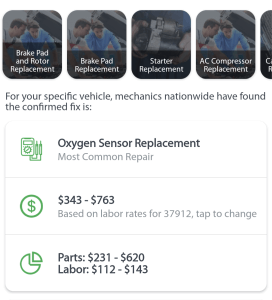The Average Cost to Replace an Oxygen Sensor Is $155 to $500 Depending on if You Go to the Mechanic or DIY
These prices are based on national averages. Related repairs or maintenance may also be required. For a more accurate estimate based on your make, model, and location, as well as automatic maintenance alerts to inform you when it’s time to replace your oxygen sensor, check out the FIXD Sensor and free app!
Get a more accurate estimate with FIXD!
With the FIXD Sensor and app, you get repair costs, engine diagnostics, maintenance alerts, and more!

Cost at the Mechanic: $275 to $500
- Parts: $155 to $380
- Labor: $120 (for average labor time of 1 hour)
- Projected add-on costs: $25 miscellaneous exhaust gasket
Oxygen sensors are routine maintenance items that ensure your engine is operating at peak efficiency. They should be inspected and replaced periodically to avoid issues. The cost to replace an oxygen sensor varies greatly depending on your vehicle and the brand of the sensor. While some sites say that certain sensors cost as little as $20, we recommend that drivers invest in good, quality brands since the oxygen sensor is such an important part of the vehicle. The final price of the parts required can run you anywhere from $155-$380 depending on how many sensors you need replaced and their quality. Labor typically costs around $120, with the average amount of labor time required being 1 hour.
The FIXD Sensor and free app tracks important maintenance like oxygen sensor replacement for you so that you can keep your car running as smoothly and efficiently as possible. FIXD also translates your check engine light into simple terms on your smartphone. It works with all cars made after 1996. Click here to get FIXD for $19.99 and get automatic maintenance alerts!
Want to learn more about the basics of car maintenance so you can avoid major repairs? Download our free guide here!
Cost to DIY: $155 to $380
- Difficulty level: Intermediate
- Parts needed: Oxygen sensor
There is a pretty significant difference in cost between having a mechanic replace your Oxygen Sensor and doing it yourself. FIXD recommends that if you feel comfortable doing so, you should attempt to change the sensor out yourself, as it is a pretty simple task, and it can save you hundreds of dollars.
If you get stuck, you can always reach out to our Mechanic Hotline for help. FIXD Mechanic Hotline is available at no cost with a FIXD Premium membership. Click here to get FIXD for only $19.99, including a free 14-day trial of FIXD Premium!
What Is an Oxygen Sensor?
The oxygen sensor (commonly referred to as an “O2 sensor”, as O2 is the chemical formula for oxygen) is mounted in the exhaust manifold of the vehicle to monitor how much unburned oxygen is in the exhaust as the exhaust exits the engine.
Typically, there are one or two sensors in front of your catalytic converter, and one behind it. Comparing data from before and after the catalytic converter also tells the computer how well it is working and if there are any problems with your emission system as well.
By monitoring oxygen levels and sending this information to your engine’s computer, these sensors let your car know if the fuel mix is running rich (not enough oxygen) or lean (too much oxygen). Proper air fuel ratio is critical to keeping your car running as smoothly as it should be.
What Happens If You Don’t Replace a Bad Oxygen Sensor?
When an oxygen sensor fails, there are a variety of diagnostic trouble codes (DTCs) that can pop up. Most of the time, a faulty oxygen sensor will result in a check engine light accompanied with a fault code that you can read with an OBD2 scanner like FIXD. Based on this fault code, it will point to how it failed and then move forward with the diagnosis.
Continuing to drive with a faulty oxygen sensor can cause the engine to run rough, and potentially cause a lack of power or even engine damage. The check engine light being on will also cause you to fail an emissions test if you live in an area that includes them in car inspections.
How Often to Replace Oxygen Sensors
The oxygen sensor is not a routine maintenance item. They do fail from time to time, though, triggering a check engine light. Use an OBD2 scanner like FIXD to determine the cause of the check engine light. If the trouble code indicates bad data from an oxygen sensor, it’s time to replace it. Unlike other items, you don’t need to replace all of the oxygen sensors at the same time when one fails.
Oxygen sensor replacement is a critical repair that should be completed within 3 months to avoid vehicle damage. The amount of oxygen sensors a vehicle has varies. Every car made after 1996 is required to have an oxygen sensor upstream and downstream of each catalytic converter. It is important that your oxygen sensors are functioning properly so that your vehicle’s computer can know if your exhaust has the correct air to fuel ratio at a given time. This helps prevent your engine from running too rich or too lean, which in turn prevents excess emissions being created by your vehicle. It is good to periodically replace your oxygen sensors in order to make sure your vehicle is operating at peak fuel efficiency.
Common Symptoms You Need to Replace the O2 Sensor
Symptoms of a faulty oxygen sensor may include the following:
- Check engine light
- Lean or rich running condition
- Poor acceleration
- Engine hesitation
- Black smoke from tailpipe (rich running condition) black smoke is excess fuel exiting the exhaust
- Rough idle
- Vehicle stalling out
- Reduced fuel efficiency
Claim Your Custom Maintenance Schedule
Get the FIXD Sensor and free app today for a custom maintenance schedule based on your make, model, and mileage. Never miss important maintenance again with automated maintenance alerts!

Recovering autocross and track day enthusiast. Once turned a VW Jetta into a pickup truck. Lives in a van down by the river. Dream car: 2001 Subaru WRC rally car.












